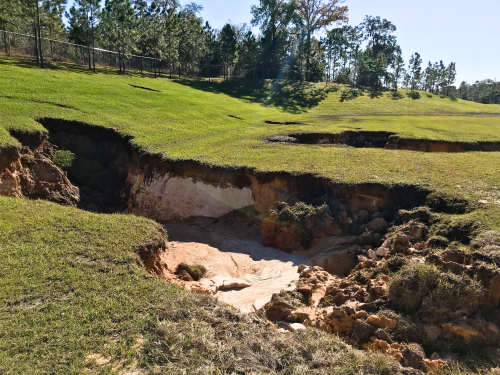According to the Florida Department of Environmental protection: “Sinkholes are a common feature of Florida’s landscape.” Unfortunately, the typical homeowners insurance policy excludes coverage for sinkhole losses. However, it may be added via endorsement. The typical endorsement for sinkhole coverage provides that a “sinkhole loss” (defined as “structural damage to the principal building, including the foundation caused by sinkhole activity”) will be paid up to the policy’s limit. Although this is a significant additional coverage available to homeowners, there is an important condition attached that can trip up homeowners.
The typical endorsement for sinkhole loss coverage requires the homeowner to, “enter in a contract for the performance of building stabilization or foundation repairs” before payment to perform such repairs will begin. Thereafter, payment for building stabilization and foundation repairs will be made as the work is performed and as the expenses are incurred. Although this requirement and policy condition appear to be straightforward, several recent appellate cases indicate that homeowners are continuing to face difficulties in obtaining coverage under the sinkhole endorsement.
In Citizens Property Insurance Corporation v. Blaha, the policyholders obtained a jury verdict against Citizens for damages caused by a sinkhole. Citizens’ engineer concluded that sinkhole activity could not be ruled out as a cause of some of the damage to the home, and Citizens tendered an initial sum for cosmetic repairs to the dwelling. The policyholders obtained various estimates for stabilization and foundation repair, as well as for repairs to the dwelling. The policyholders obtained and executed a contract for the stabilization and foundation repairs that included a process known as chemical grouting. However, the contract was never approved by Citizens because it did not match Citizens’ engineer’s recommendations.
The policyholders sued, and Citizens invoked the neutral evaluation process under Florida Statutes. The neutral evaluator concluded that stabilization and repair, with compaction and chemical grouting, was required, and generated estimates for this work and additional above-ground repairs. Citizens informed the policyholders that they would comply with the recommendations of the neutral evaluator, and advised the policyholders to select a contractor to perform the stabilization and repair work. Citizens informed the policyholders that they would make payments once the contract for stabilization and repair work was entered into. The policyholders rejected this proposal and took the case to a jury trial, where they prevailed. This victory was reversed, in part, on appeal.
During the trial, Citizens filed a motion for directed verdict on the grounds that the initial contract that the policyholders submitted was not in accordance with Citizens’ engineer’s recommendations. The trial court denied this motion, and that denial was upheld on appeal. Thus, if the policyholders submit a contract for stabilization and repair related to a sinkhole, and the policyholders and insurer have a bona fide dispute about the method and means necessary to perform subsurface stabilization and repairs, then this question will go to a jury. However, the appellate court reversed the monetary judgment for the full amount of subsurface repairs because the policyholders had not entered into a contract for those repairs. Thus, policyholders are still required to enter into a contract for subsurface stabilization and repairs before payment is due for that work.
In Citizens Property Insurance Corporation v. Simoneau, Citizens conceded the existence of sinkhole activity, but disputed the method of subsurface stabilization and repair. The policyholders prevailed at trial and obtained a monetary judgment. The judgment was reversed because the judgment awarded damages without requiring the policyholders to enter into a contract for the subsurface stabilization and repairs.
In Citizens Property Insurance Corporation v. Cabrera, Citizens challenged whether damage to the insureds’ home was caused by sinkhole activity. The policyholders prevailed at trial and obtained a monetary judgment. Once again, the judgment was reversed because the judgment awarded damages without requiring the policyholders to enter into a contract for subsurface stabilization and repairs.
In Case v. Tower Hill Prime Insurance Co., Tower Hill obtained a summary judgment against the policyholders that was reversed on appeal. After noticing damage to their home, the policyholders submitted a claim to Tower Hill, who engaged an expert to determine whether the damage was caused by sinkhole activity. Tower Hill acknowledged sinkhole activity, but refused to pay until the policyholders entered into a contract for subsurface stabilization and repair. The policyholders disagreed with the estimated costs of the necessary subsurface stabilization and repair and retained their own engineer. The dispute went to neutral evaluation, and the neutral evaluator agreed that subsurface stabilization and repair was necessary and provided his own estimate of the required work that was between the insured and insurer’s estimates. The policyholders disagreed with the neutral evaluator’s report and estimate, and filed a lawsuit. The policyholders obtained additional engineering evaluations and estimates. Tower Hill filed a motion for summary judgment, arguing that it was only required to pay for subsurface stabilization and repairs indicated by its own engineer’s report. On appeal, Tower Hill conceded that this was error. When there is a genuine dispute regarding the proper method of subsurface stabilization and repair, the policy requirement to sign a contract for such repairs is premature.
In review of the cases summarized above, there are a few points to keep in mind regarding sinkhole claims. First, genuine disputes regarding the method and scope of subsurface stabilization and repairs must be decided by a jury. Second, if the policyholder prevails, the requirement to have a contract for subsurface stabilization and repairs will still control the timing and scope of all payments made by the insurer pertaining to those repairs.





